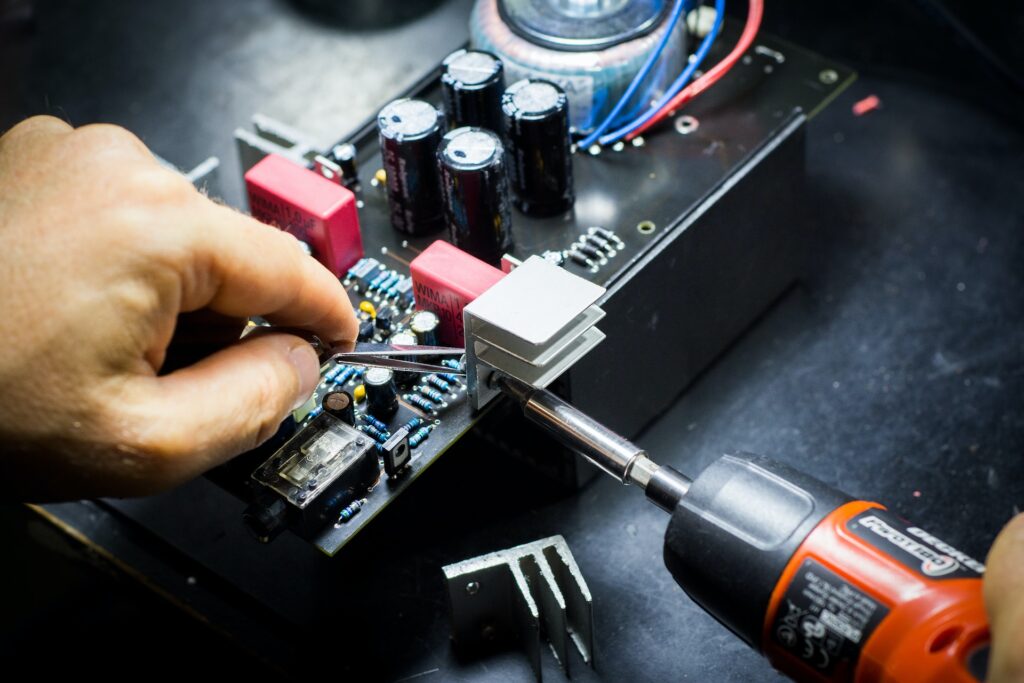Introduction:
Electronic circuits are fundamental to the functioning of modern technology, and they are the backbone of all electronic devices. In this article, we will explore what electronic circuits are, how they work, and their real-life applications.
What is an Electronic Circuit?
An electronic circuit is a network of electronic components that work together to perform a specific function. It consists of electronic components such as resistors, capacitors, transistors, diodes, and integrated circuits, connected together to form a closed loop or pathway. The components are arranged in a specific order and configuration, which determines the function of the circuit.
How do Electronic Circuits Work?
Electronic circuits operate by controlling the flow of electrons through the components in the circuit. The flow of electrons, or current, is regulated by the voltage applied across the circuit. The voltage is provided by a power source such as a battery or power supply.
The components in the circuit act as resistors, capacitors, transistors, or diodes to control the flow of current. Resistors are used to limit the current in the circuit, while capacitors store and release electrical charge. Transistors and diodes control the flow of current by acting as switches, amplifiers, or rectifiers.
Types of Electronic Circuits:
Electronic circuits can be classified into two broad categories: analog circuits and digital circuits.
Analog Circuits: Analog circuits are circuits that operate using continuous electrical signals that vary in magnitude and frequency. They are used for applications that require accurate measurement and control of signals, such as in audio and video systems, instrumentation, and communication systems.
Digital Circuits: Digital circuits operate using discrete values of voltage or current that represent binary digits or bits. They are used in digital devices such as computers, calculators, and mobile phones.
Examples of Electronic Circuits:
- Amplifier Circuit: An amplifier circuit is a type of electronic circuit that amplifies a small input signal to a larger output signal. It is used in audio systems, radio receivers, and other electronic devices that require amplification of signals.
- Oscillator Circuit: An oscillator circuit is a type of electronic circuit that generates a periodic waveform such as a sine wave or a square wave. It is used in electronic devices such as clocks, radios, and electronic musical instruments.
- Power Supply Circuit: A power supply circuit is a type of electronic circuit that provides a regulated output voltage or current to power electronic devices. It is used in electronic devices such as computers, mobile phones, and other electronic equipment.
- Sensor Circuit: A sensor circuit is a type of electronic circuit that senses a physical or environmental parameter such as temperature, light, or sound. It is used in electronic devices such as thermostats, smoke detectors, and security systems.
Real-life Applications of Electronic Circuits:
Electronic circuits are used in a wide range of applications in our daily lives, from simple household appliances to sophisticated medical equipment. Some of the real-life applications of electronic circuits are:
- Medical Equipment: Electronic circuits are used in various medical equipment such as CT scanners, MRI machines, and heart monitors. These devices use electronic circuits to generate and analyze signals to diagnose and treat various medical conditions.
- Communication Systems: Electronic circuits are used in communication systems such as telephones, radios, and satellite systems. They are used to transmit and receive signals over long distances and are essential for modern communication.
- Transportation: Electronic circuits are used in various transportation systems such as cars, trains, and airplanes. They are used in engine control systems, braking systems, navigation systems, and entertainment systems.
- Household Appliances: Electronic circuits are used in various household appliances such as refrigerators, washing machines, and microwave ovens. They are used to control the operation of these appliances and to provide safety features.
Conclusion:
In conclusion, electronic circuits are the building blocks of modern technology and are used in a wide range of applications in our daily lives. They are used in everything from household appliances to sophisticated medical equipment, and they are essential for modern communication and transportation systems.
As electronic students, it is essential to have a good understanding of electronic circuits, their components, and their applications. By understanding the principles of electronic circuits, you will be able to design and build electronic devices that are reliable, efficient, and effective.
In summary, electronic circuits are fascinating and complex systems that are critical to the functioning of modern technology. They are an essential part of the electronics field, and as electronic students, it is our responsibility to learn and master this important topic.
